Year 2 White Rose Overview
With thanks to Third Space Learning for this overview:
Topics covered in Year 2 White Rose Maths scheme of learning work
Year 2 autumn term
- Place value
- Addition and subtraction
- Shape
Year 2 spring term
- Money
- Multiplication and division
- Length and height
- Mass, capacity and temperature
Year 2 summer term
- Fractions
- Time
- Statistics
- Position and direction
White Rose Maths Year 2 autumn term
In the autumn block, Year 2 focuses on place value, addition & subtraction and shape
Place Value Year 2
Place value is a significant proportion of the autumn Year 2 maths curriculum. Students begin the block, focusing on: numbers to 20; counting objects to 100 and recognising tens and ones (using materials and a range of representations to do this). They use a place value chart to partition numbers to hundred and learn to write numbers to 100 in words. Students are also introduced to the < , > and = symbols to compare and order numbers to 100 and learn to count in steps of 2, 3 and 5 from zero.
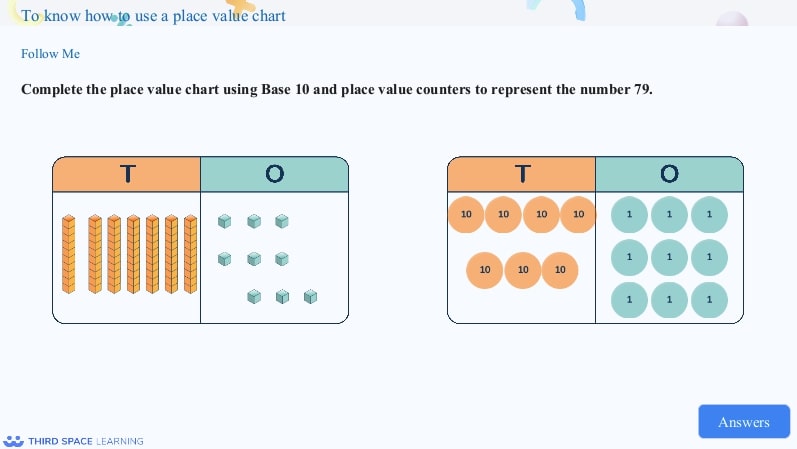
In Year 2, pupils use place value charts to represent numbers to 100.
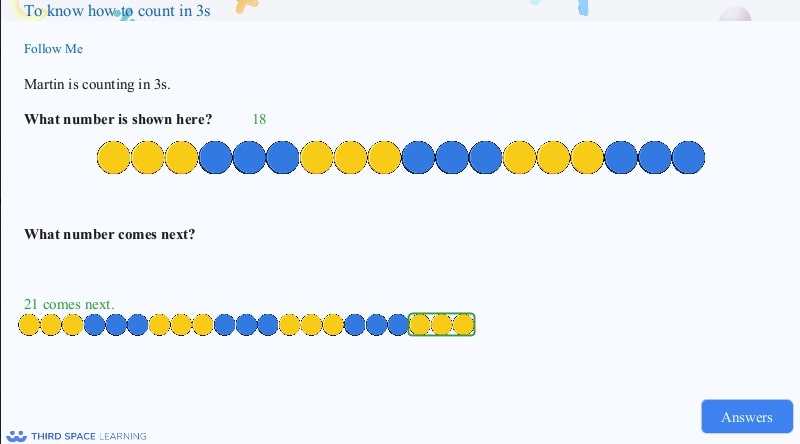
Pupils should be comfortable with counting in 2s, 5s and 10s and as such,
move on to counting in 3s.
Example year 2 place value questions
1. What number is represented here. How many tens and how many ones are there?
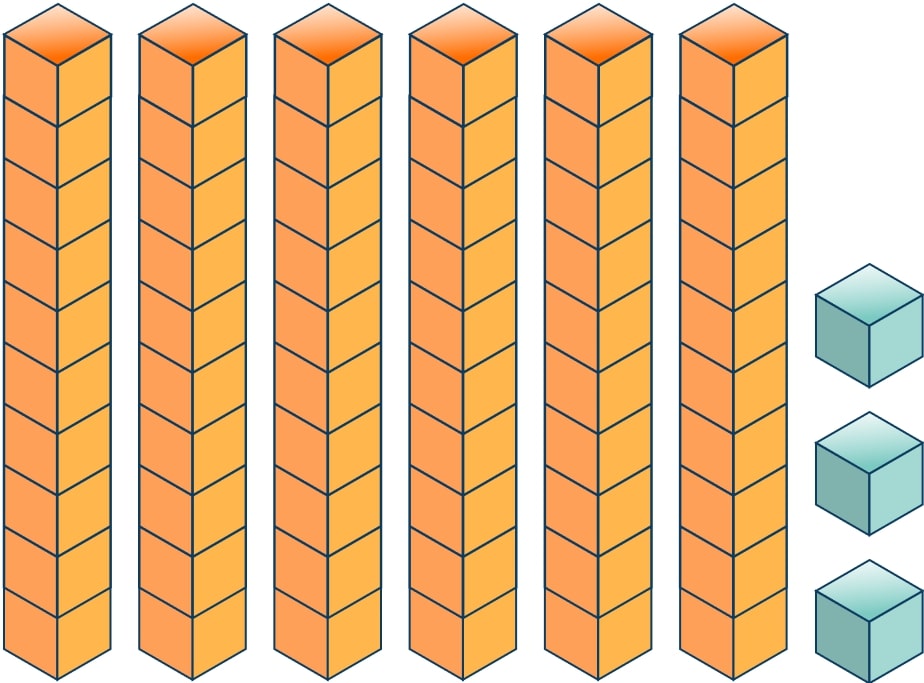
Answer: 63, 6 tens and 3 ones
2. Sam ate 14 grapes and Jamie ate 21. Did Sam eat more or less grapes than Jamie
Answer: Sam ate less grapes
Addition & subtraction Year 2
Addition and subtraction is another large block in the year 2 maths curriculum; spanning five weeks. Pupils use concrete objects and pictorial representations, applying their increasing knowledge of mental and written methods and extend their understanding of the language of addition and subtraction to include sum and difference.
Children begin by recapping number bonds to 10. They learn to recall and use addition & subtraction facts to 20 fluently, and derive and use related facts up to 100. Pupils also use concrete objects and pictorial representations to add and subtract: two-digit numbers and ones; two-digit numbers and tens; two two-digit numbers and three one-digit numbers. They also learn to recognise and use the inverse relationship between addition and subtraction and use this to check calculations and solve missing number problems.
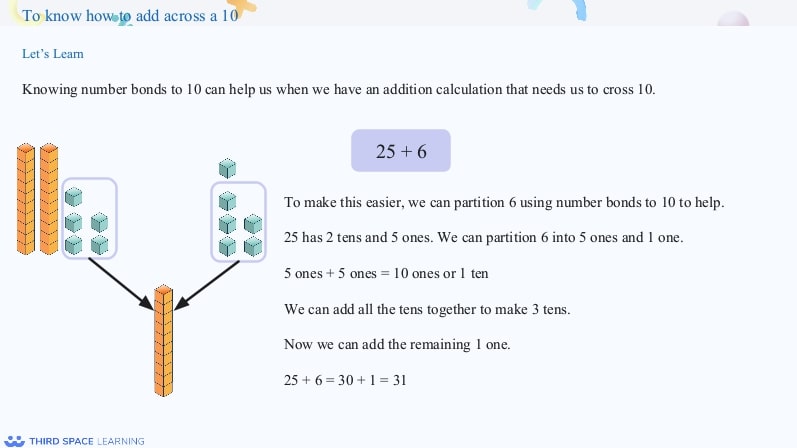
Pupils use their known number bonds to help them add across a ten.
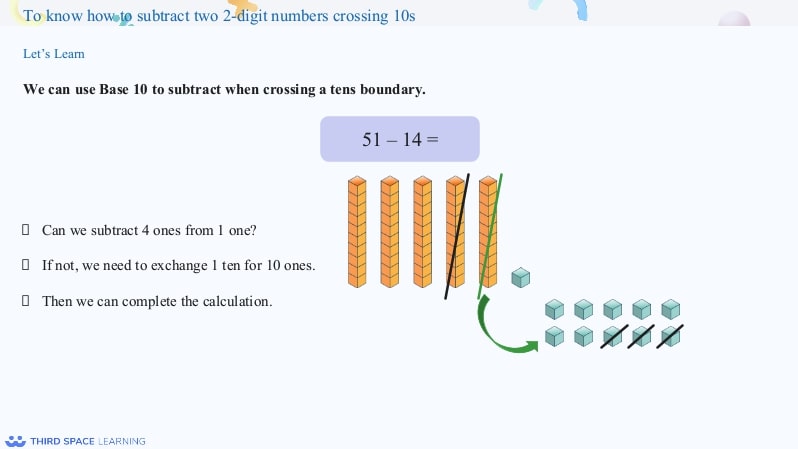
Pupils use concrete or pictorial representations to help them
understand exchanging when subtracting.
Example year 2 addition & subtraction questions
1a) 24 + 3 =
b) 57 – 4 =
Answer:
a)27
b)53
2. Sophie had 7 pencils. She gave 3 pencils to her friend. How many did she have left?
Answer: 4 pencils
Shape Year 2
Shape is the final block of the autumn term. Pupils learn to identify and describe the properties of a range of 2D, including number of sides and lines of symmetry and 3D shapes, including the number of edges, faces and vertices. Students also learn to read and write the names for the shapes; sort shapes and make patterns with both 2D and 3D shapes.
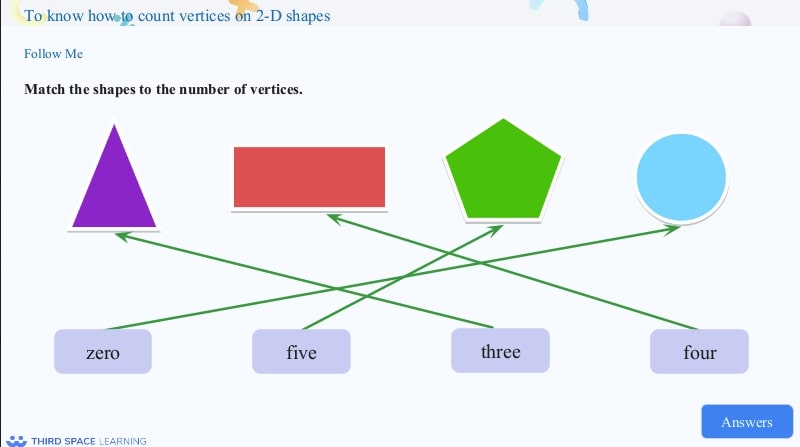
As pupils are expected to be comfortable with the names of simple 2-D shapes,
they move on to describing the properties of simple 2-D shapes.
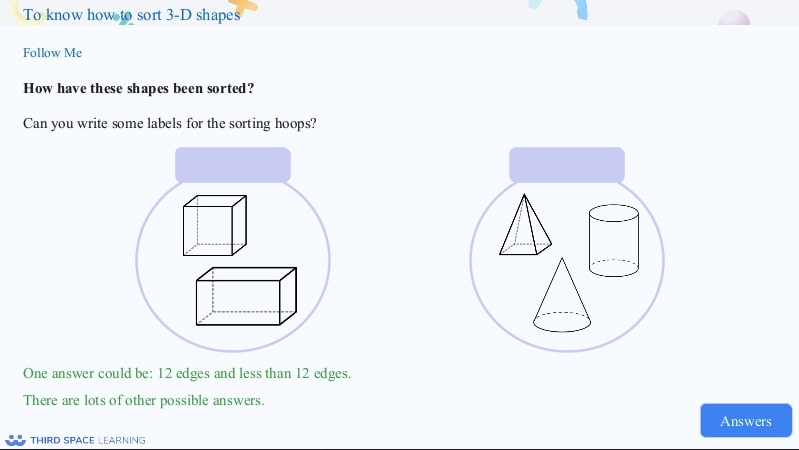
Pupils develop their understanding of 3-D shapes by sorting shapes based on their properties.
Example year 2 shape questions
1. Match the shape to the correct name:
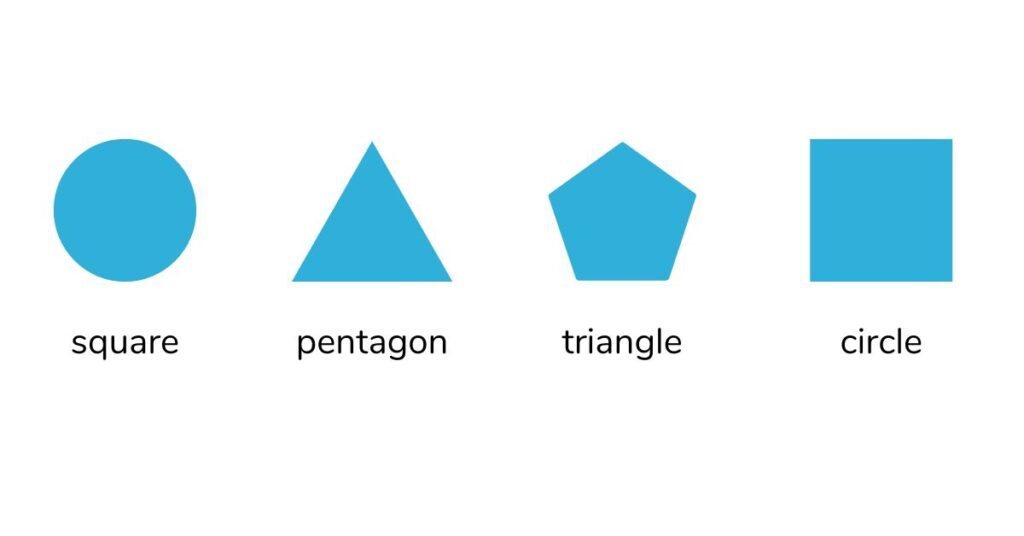
Answer:
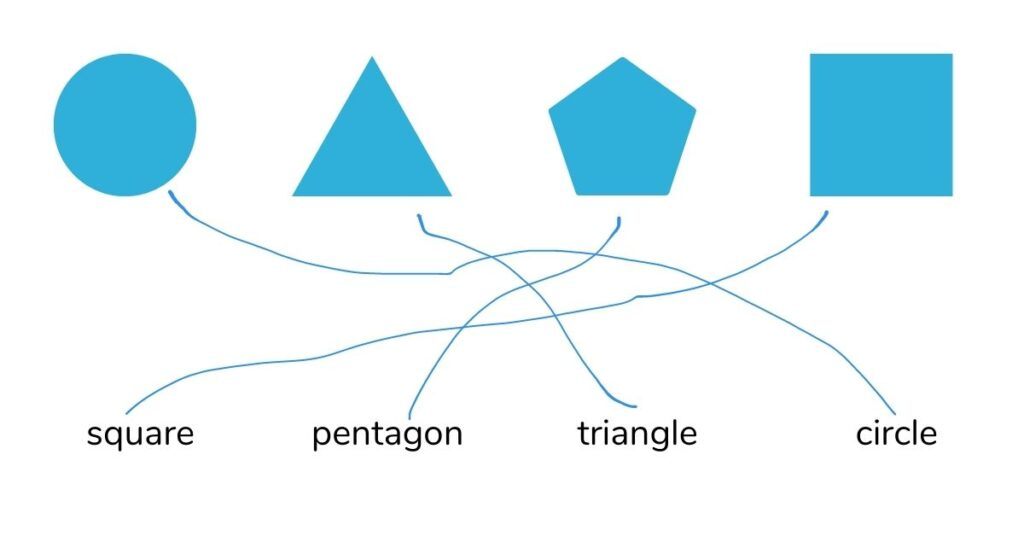
White Rose Maths Year 2 spring term
In the spring block Year 2 focuses on money, multiplication & division, length & height, and mass, capacity & temperature.
Money Value Year 2
Pupils build on their knowledge of coins from year 1, learning to recognise and use symbols for pounds and pence and combining amounts to make a particular value. Students also learn to find different combinations of coins that equal the same amounts and solve simple problems involving the addition and subtraction of money, including giving change.
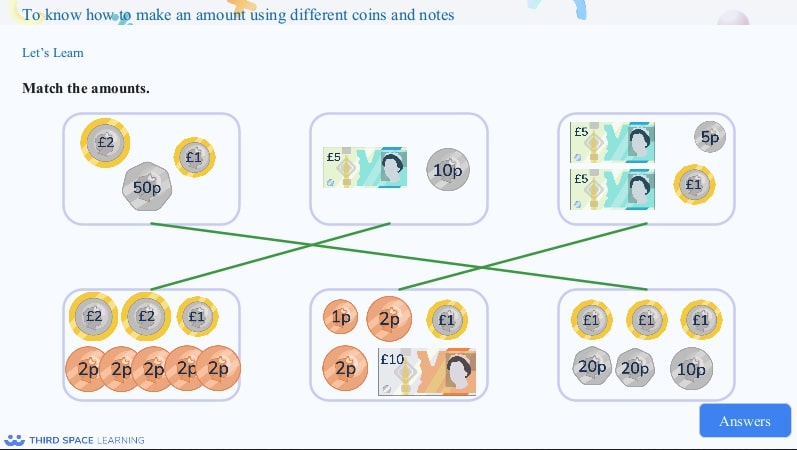
Pupils use their understanding of money to make the same amount in different ways.

Pupils are required to understand how to represent money using pounds and pence.
In Year 2, pupils do not use decimal notations.
Example year 2 money questions
1. Count the money. How much is there in total?
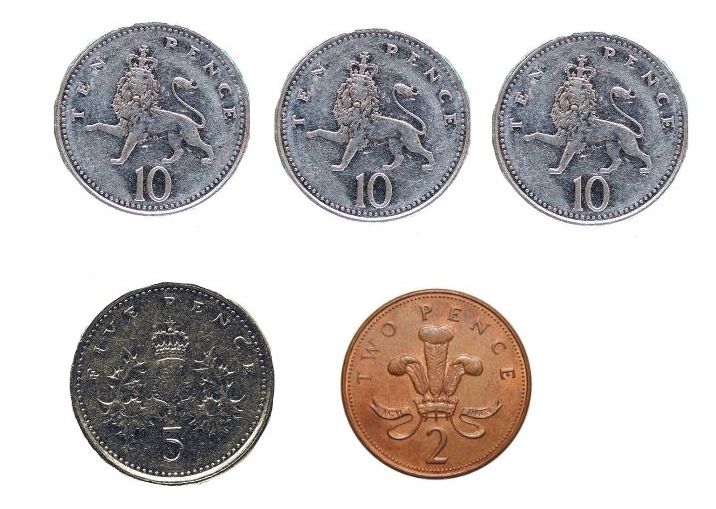
Answer: 37p
2. Mason bought a lolly for 7p and a bag of sweets for 25p. How much did he spend altogether?
Answer: 32p
Multiplication and Division Year 2
Multiplication and division is one of the largest blocks in the year 2 maths curriculum, spanning 5 weeks in total. Pupils learn to recall the multiplication and division facts and times tables for the 2, 5 and 10 multiplication tables and are introduced to the multiplication symbol. Children work with a range of practical resources and investigate a range of contexts in which multiplication and division relate to grouping and sharing, to arrays and to repeated addition.
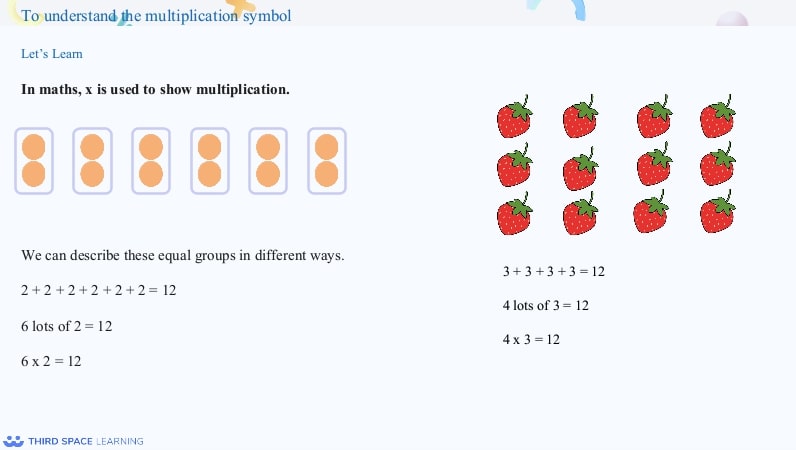
Pupils have looked at adding equal groups in Year 1, this is extended in
Year 2 when the multiplication symbol is introduced.
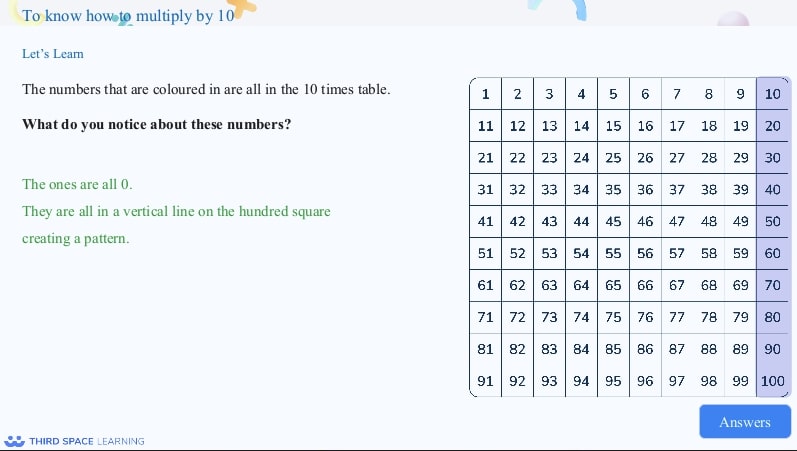
Previously, pupils have counted in tens. In Year 2, they relate this information to multiplication.
Example year 2 multiplication and division questions
1. There are 8 pencils in a pack. How many are there in 2 packs?
Answer: 16
2. Hamza shares his 20 sweets between him and his 4 friends. How many sweets do each of the 5 children get?
Answer: 5 sweets each
Length and height Year 2
Pupils build on their understanding of measures from year 1, to begin using standard units of measurement with increasing accuracy. Children learn to measure in centimetres and metres and to compare and order lengths & heights.

Pupils learn to use a ruler, starting at 0 (not the end of the ruler) to measure items.
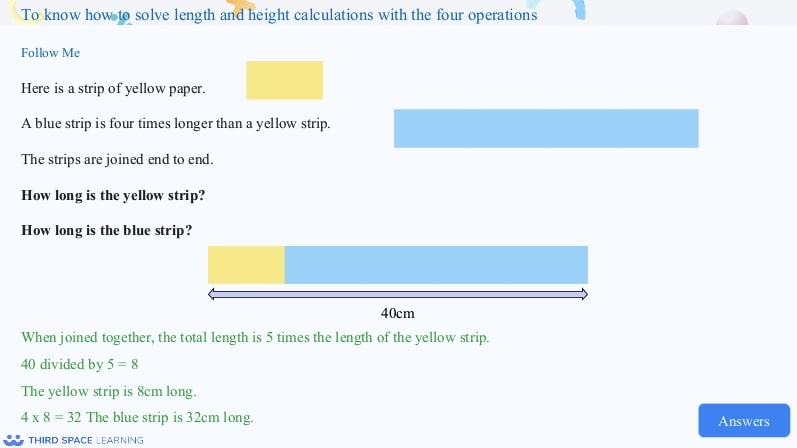
Pupils apply their understanding of the four operations to calculations involving measures.
Example year 2 length and height questions
1. What is the length of the toy car?
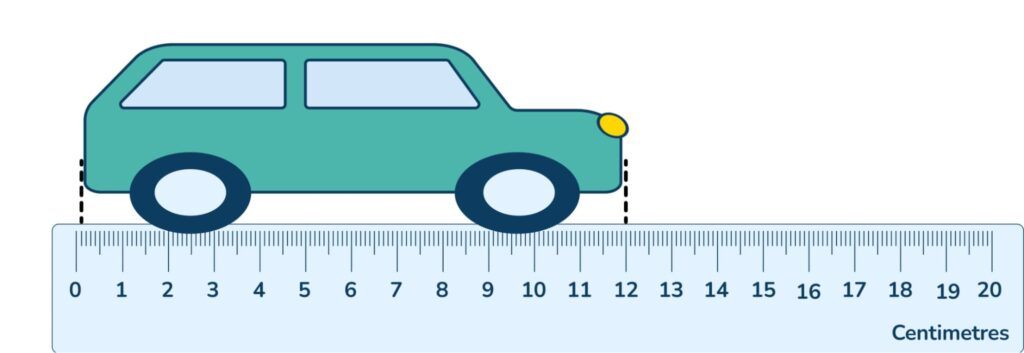
Can you put a ruler this and a picture of something like a toy car, for children to measure?
Answer: 12cm
Mass, capacity and temperature Year 2
In year 2, pupils are introduced to mass, capacity and temperature, and learn to measure in grams, kilograms, millilitres and litres. The four operations are used to solve problems with both mass and capacity and children begin using ℃ to describe temperature.
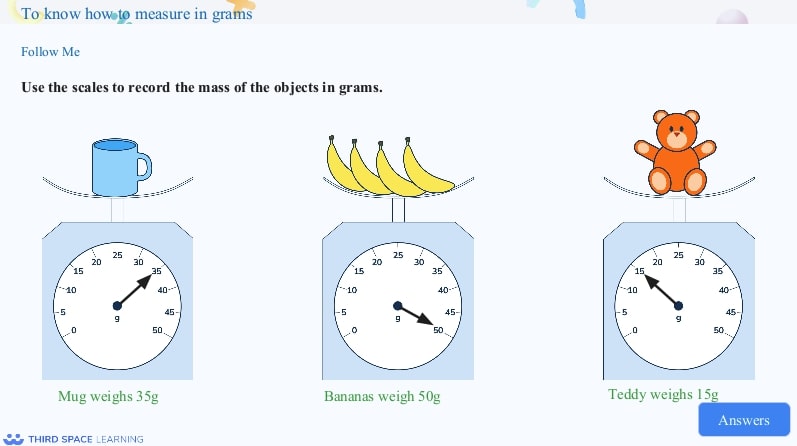
Pupils learn to measure mass in grams or kilograms.
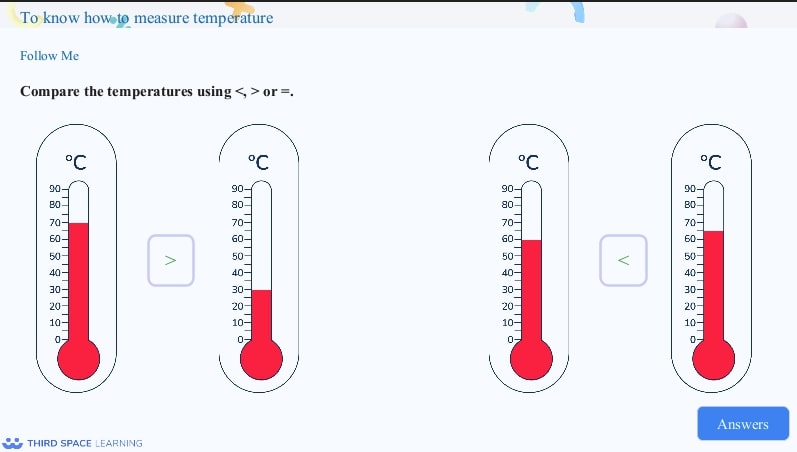
Year 2 is the only year group that explicitly explores temperature
as part of their measurement blocks of learning.
Example year 2 mass, capacity and temperature questions
1. What is the capacity of the jug?
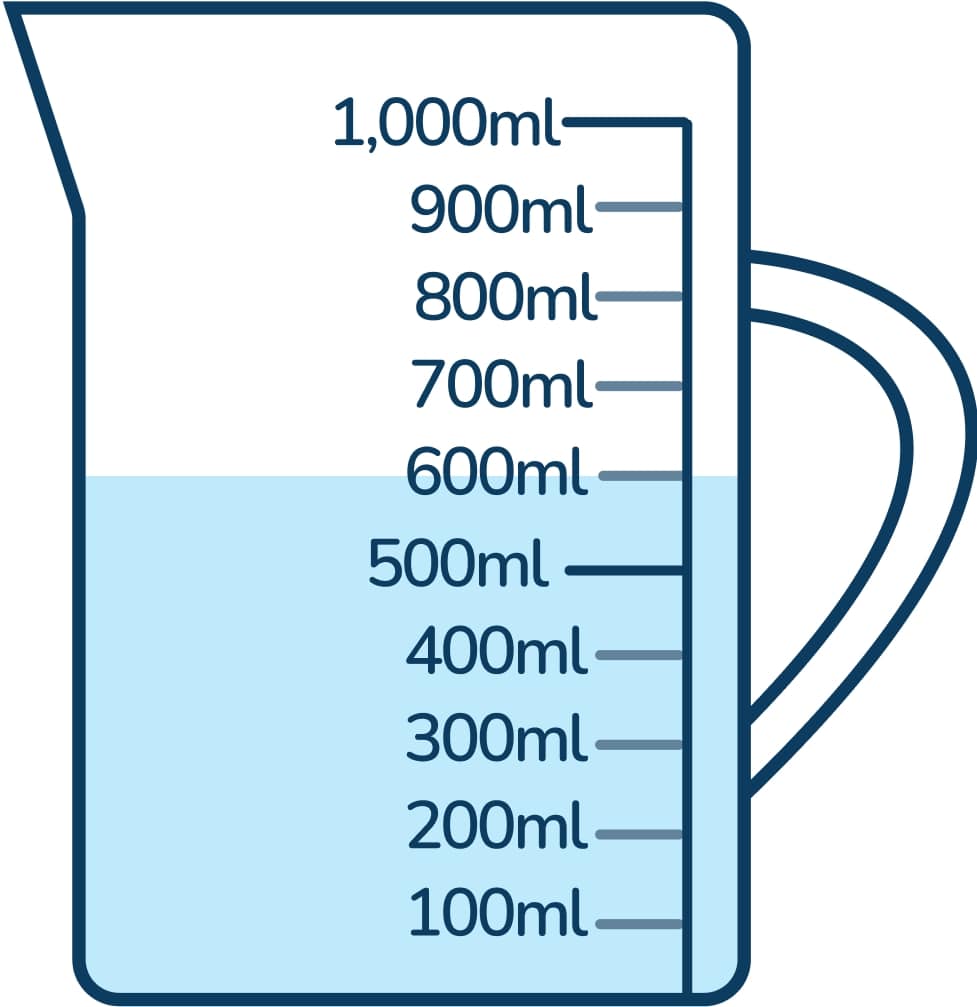
Answer: 600ml
2. Maisie is doing some baking. She measured out 50g of flour and 25g of sugar. How much flour and sugar does she have altogether?
Answer: 75g
White Rose Maths Year 2 summer term
In the summer block Year 2 focuses on: fractions, time, statistics and position & direction.
Fractions Year 2
In year 2, pupils begin by exploring the concept of parts/whole and equal/unequal parts. Children learn to recognise and find a half, a third and a quarter and are introduced to the terms ‘unit’ and ‘non-unit’ fraction. Pupils also solve problems using shapes, objects and quantities and learn how to count in fractions up to a whole.
Example year 2 fractions questions
1. Colour in the fraction given on each shape.
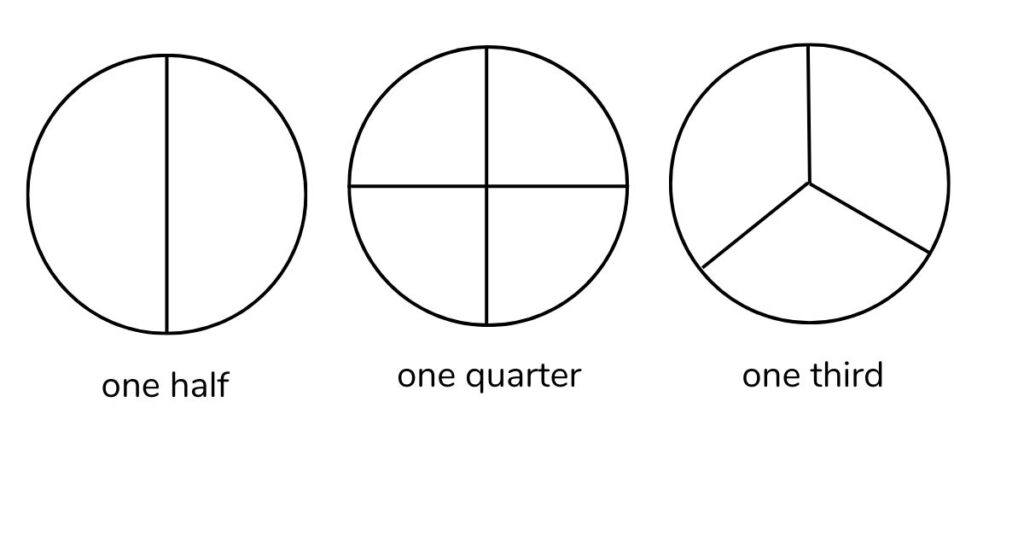
Answer:
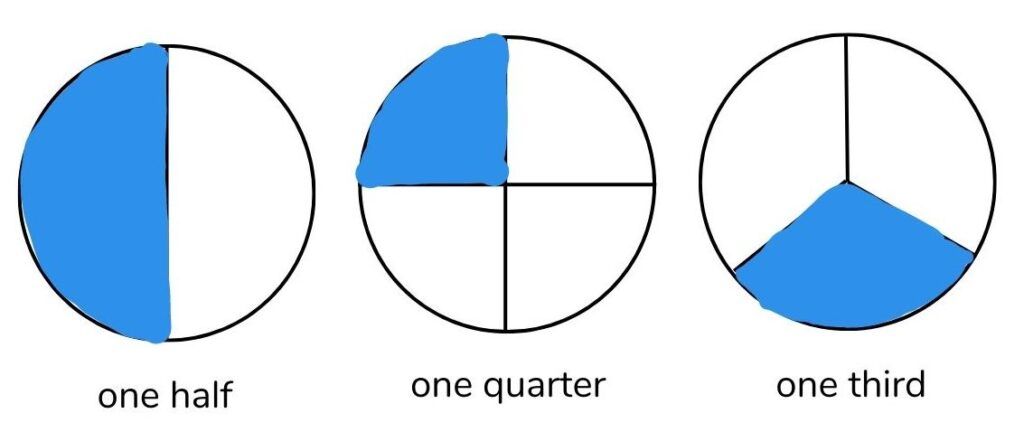
2. Abdulla had 14 sweets. He gave half of them to his friend. How many sweets did he have left?
Answer: 1221 of 14 = 7 sweets
Time Year 2
In year 2, pupils become more fluent in telling the time on an analogue clock; progressing from telling the time to o’clock and half past, to learning to read the time to five minutes, including quarter past and quarter to. By this stage, children should also know how many minutes in an hour and the number of hours in a day.
Example year 2 time questions
1. Draw hands on the clock so it is showing 20 past 5.
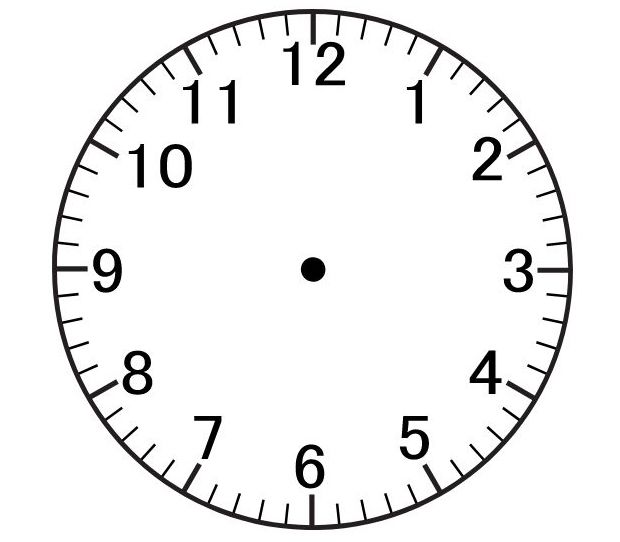
Answer:
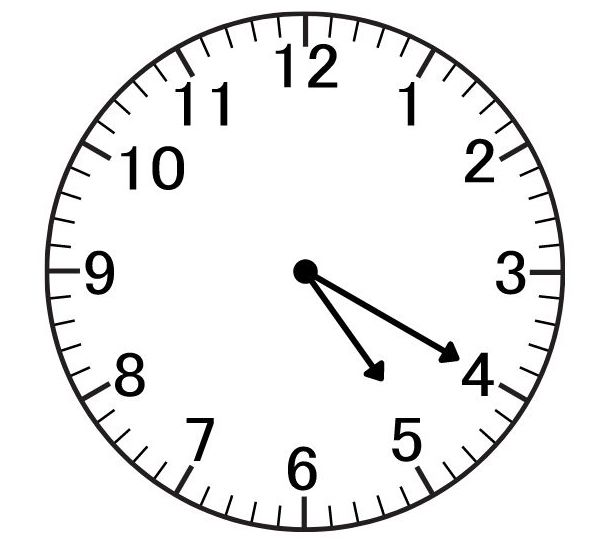
2. Oliver got on the bus at 10 o’clock and got off again at half past 10. How long was he on the bus for?
Answer: Half an hour / 30 minutes
Statistics Year 2
Pupils record, interpret, collate, organise and compare information. They learn to construct simple pictograms, tally charts, block diagrams and tables and answer questions by counting the number of objects in each category and sorting the categories by quantity.
Example year 2 statistics questions
1. Zanab carried out a survey on the favourite foods for children in her year group. She recorded the results as a tally chart.
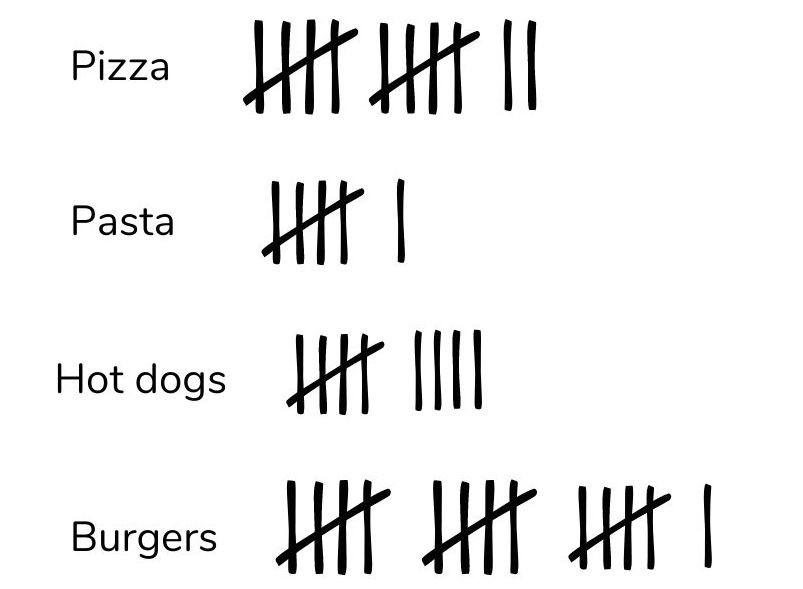
a) What was the most popular food?
b) Which was the least popular food?
c) How many children chose hot dogs as their favourite food?
d) How many more children chose pizza than pasta?
Answer
a) Burgers
b) Pasta
c) 9 children
d) 6 more children
Position and Direction Year 2
In year 2, pupils learn to describe movement and turns, using the language of angles. They also learn to work with patterns of shapes, including those in different orientations.
Example year 2 position & direction questions
1. a) Use the words forwards, backwards, left and right to plan a route home for the cat.
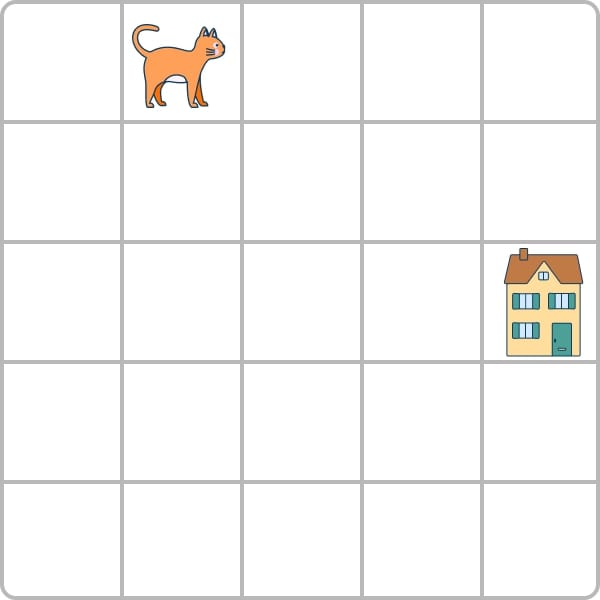
Answer: 3 squares forwards and 2 squares right (other routes are possible, for example 2 squares down and 3 squares right)
